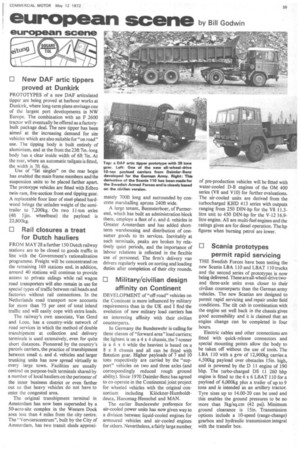0 Military/civilian design affinity on Continent
Page 65

If you've noticed an error in this article please click here to report it so we can fix it.
DEVELOPMENT of "off-road" vehicles on the Continent is more influenced by military requirements than in the UK and I find the evolution of new military load carriers has an interesting affinity with their civilian counterparts.
In Germany the Bundeswehr is calling for three classes of "forward area" load carriers; the lightest is on a 4 x 4 chassis, the 7-tonner is a 6 x 6 while the heaviest is based on a 8 x 8 chassis and all can be fitted with flotation gear. Higher payloads of 7 and 10 tons respectively are carried by the "support" vehicles on two and three axles (and correspondingly reduced rough ground ability). Since 1970 Daimler-Benz has agreed to co-operate in the Continental joint project for wheeled vehicles with the original consortium including Klockner-Humboldtdeutz, Hanomag-Henschel and MAN.
The earlier Bundeswehr preference for air-cooled power units has now given way to a division between liquid-cooled engines for armoured vehicles and air-cooled engines for others. Nevertheless, a fairly large number_ of pre-production vehicles will be fitted with water-cooled D-B engines of the OM 400 series (V8 and V10) for further evaluations. The air-cooled units are derived from the turbocharged KHD 413 series with outputs ranging from 250 DIN-hp for the V8 11.3litre unit to 450 DIN-hp for the V-12 16.9litre engine. All are multi-fuel engines and the ratings given are for diesel operation. The hp figures when burning petrol are lower.
















































































































































































































